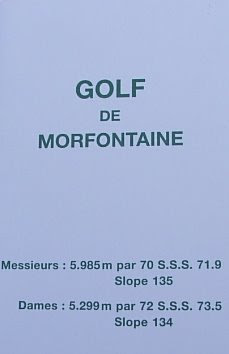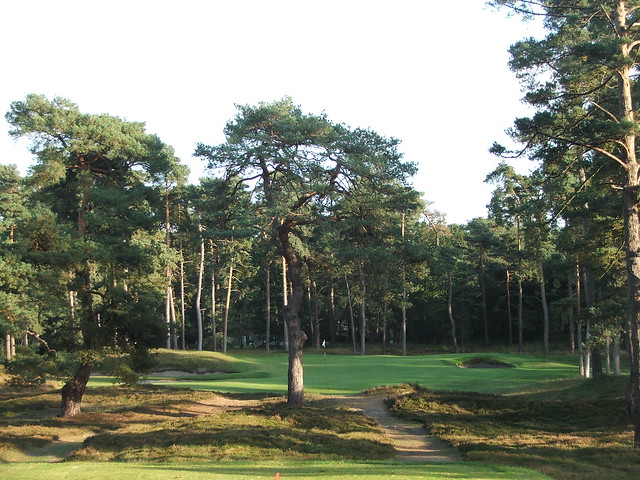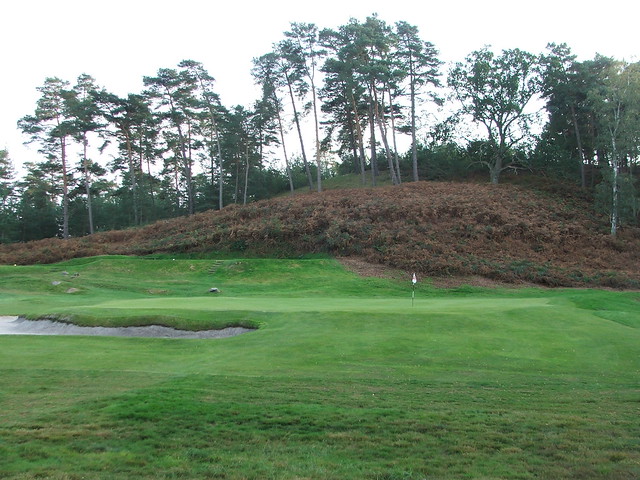
I am blessed to live within a three hour car ride of fourteen of the top one hundred golf courses in the world. For someone seeking golf's holy grail, there is no better place to live. I recently played Quaker Ridge Golf Club (ranked #61 in the world) on a beautiful, crisp fall day. I have now completed playing all eleven of the world-ranked courses in New York.
Quaker Ridge is located in New York's Westchester County, immediately adjacent to Winged Foot, in Scarsdale, New York. Scarsdale is an extremely affluent suburb of New York and has a bit of a New England feel to it with its rolling terrain, low stone walls bordering many properties, and its stately, mature trees. Quaker Ridge takes its name from a group of Quakers who used this land for farming beginning in 1726. The "ridge" part of the name becomes obvious when you play the course. Quaker Ridge is blessed with much better terrain that its nearby neighbor Winged Foot, which is on more-or-less flat ground.
Quaker Ridge is one of the least well known of the world's great courses. I like to research courses prior to playing them and had a hard time finding much information about Quaker Ridge. They have published no club history; it is hard to find pictures of the course and they shy away from publicity. As is their right, the members like to keep it a low-key affair.

John Duncan Dunn designed a nine hole layout here in 1916, and A.W. Tillinghast was brought in during the 1920s to redo the course and expand it to eighteen holes. Tillinghast is responsible for the course we find here today. The course was rebunkered, and some other minor alterations were made by Rees Jones before the 1997 Walker Cup matches, which were held here.
The defining characteristics of Quaker Ridge are the trees, the out of bounds and the greens. The greens are very good, subtle and very fast; sixteen of them slope back to front. The course is in many ways a typical course found in Westchester County, which are all tree-lined. I mean this in no way to be a negative, because Quaker Ridge can hardly be described as a typical course. The other thing you notice about Quaker Ridge when you begin playing is that the angles you take coming into the greens are of paramount importance. This is the sign of a brilliantly designed and thoughtfully laid out course.

Approach to the 4th green
A good example of why the angles coming in the green are important can be illustrated with the fourth hole above. The fourth is a 384 yard par four with a narrow fairway and a green that falls sharply off a hill on the left side. As you can see above, if you are on the right side of the fairway, the trees come into play, making your approach shot likely to fall off left of the green in a large bunker. In the interest of good blogging, I actually field tested this scenario (by design, of course!) and ended up in the bunker.

4th fairway from the tee
The smarter play on this hole is to hit the ball to the left side of the fairway off the tee. Well, that's easier said than done. When you stand on the tee, you see a big grass bunker that slashes across the fairway, creating an intimidating line that you have to hit over to a blind landing area. This is a good example of the type of strategic Tillinghast design you will find at Quaker Ridge.
The same principles apply at the signature eleventh hole. There are two trees on the left side of the fairway that block your shot to the green if you are not correctly positioned on the right side of the fairway. The shot to the green tightens up your anus ever so slightly because you hit to a narrow green guarded by a stone-wall lined creek (burn for all my Scottish fans) that meanders in front of the green. Meander might be too nice a word to use because it is quite a menacing little stream, seen below.

The 11th green
My guess is that if Charles Blair Macdonald ever played at Quaker Ridge he would have had a tough go of it. Macdonald was famous for designing his courses to favor a slicer, a category he was prominently featured in. Piping Rock, The National Golf Links of America and Chicago Golf Club, all Macdonald designs, penalize those that hook the ball, but are friendlier to the slicer. The first eight holes at Quaker Ridge have an out-of-bounds along the right side of the hole.
The first eight holes circle the property in a counter-clockwise fashion, which is the mirror image of Chicago Golf, which circles in a clockwise fashion. The next six holes at Quaker Ridge circle back in a clockwise fashion, before play goes back toward the club house. I know that Royal Liverpool (Hoylake) is probably the most famous world-renowned course that has a lot of O.B. Having played both courses, I think Quaker Ridge is a much sterner test of trying to keep the ball in play. At Hoylake, the O.B. really doesn't come into play unless you are truly wild. At Quaker Ridge, it comes into play if you are only mildly off line.

The approach to the 7th hole
As if all the O.B. on the right side of each hole is not enough, the 7th hole, a par four seen above also has O.B. if you hit the ball long. For the record, I didn't hit a ball O.B. while playing Quaker Ridge. A sigh of relief is in order when you get to the ninth tee box and most of the O.B. is behind you.
The best stretch of holes on the course are six through eleven. Six and seven are back to back, dog-leg right par four holes. Eight is a good 335 yard short par four and nine is a tough par three with a tiny green. Six and seven might be as difficult a pair of par fours as you will find on any course. They are the #1 and #3 handicaps, respectively. The sixth has a creek running down the left hand side and is in play off the tee. The right hand side of the hole has a grass slope on the right (with the obligatory O.B.), and the fairway between the slope and water is about twenty five yards wide. The hole plays longer than its 434 yards because the shot to the small green plays uphill. The dog-leg is quite severe and to add additional difficulty there is a big tree on the right side of the hole that must be avoided off the tee. In his book, The 500 Greatest Golf Holes, George Peper, ranks this hole in an unprecedented three categories of composite courses of eighteen holes. Among the 18 most strategic holes in the world, it ranks as one of the 18 best holes ever designed by A.W. Tillinghast and as one of the 18 most difficult holes in the world. I would have to agree on all counts.
There is no let-up on the next hole: a 419 yard par four that also has a sharp dog-leg, a stream running through the middle and also plays to an uphill green. This tee shot is also quite difficult because there is again O.B. right, and if you hit too far left your ball will run through the fairway.


As you come in to the closing stretch of holes, it becomes clear that there must have been a circus in town as Tillinghast completed the layout. Sadly, several elephants must have died as the circus came through New York since Tilly buried three of them under his greens. The 14th, 15th and 17th holes have major undulations in them and several ridges and humps reminiscent of buried elephants. If you look closely at the picture above, and to the right of the pin on the par five 14th hole, you can see one such hump. They are quite good and add a lot of character to the finish at Quaker Ridge. Most of the other holes at Quaker RIdge have very subtle breaks to the fast greens; these are not subtle.
The best stretch of holes on the course are six through eleven. Six and seven are back to back, dog-leg right par four holes. Eight is a good 335 yard short par four and nine is a tough par three with a tiny green. Six and seven might be as difficult a pair of par fours as you will find on any course. They are the #1 and #3 handicaps, respectively. The sixth has a creek running down the left hand side and is in play off the tee. The right hand side of the hole has a grass slope on the right (with the obligatory O.B.), and the fairway between the slope and water is about twenty five yards wide. The hole plays longer than its 434 yards because the shot to the small green plays uphill. The dog-leg is quite severe and to add additional difficulty there is a big tree on the right side of the hole that must be avoided off the tee. In his book, The 500 Greatest Golf Holes, George Peper, ranks this hole in an unprecedented three categories of composite courses of eighteen holes. Among the 18 most strategic holes in the world, it ranks as one of the 18 best holes ever designed by A.W. Tillinghast and as one of the 18 most difficult holes in the world. I would have to agree on all counts.
There is no let-up on the next hole: a 419 yard par four that also has a sharp dog-leg, a stream running through the middle and also plays to an uphill green. This tee shot is also quite difficult because there is again O.B. right, and if you hit too far left your ball will run through the fairway.

The 8th hole from the tee
The genius of the routing at Quaker Ridge is how the holes fit brilliantly together. The eighth is a unique Tillinghast hole with a huge grass bunker in the middle of the fairway which rises up a hill and between rows of trees. This hole takes advantage of the typical Westchester County hilly, tree-lined terrain and is a welcome potential birdie hole after being beaten up on the last two holes. This type of varied layout makes for a continual change, and Tillinghast weaves together a coherent eighteen holes that are challenging without being overwhelming. Collectively, the layout is much greater than the sum of its eighteen individual holes.

The 14th green
As you come in to the closing stretch of holes, it becomes clear that there must have been a circus in town as Tillinghast completed the layout. Sadly, several elephants must have died as the circus came through New York since Tilly buried three of them under his greens. The 14th, 15th and 17th holes have major undulations in them and several ridges and humps reminiscent of buried elephants. If you look closely at the picture above, and to the right of the pin on the par five 14th hole, you can see one such hump. They are quite good and add a lot of character to the finish at Quaker Ridge. Most of the other holes at Quaker RIdge have very subtle breaks to the fast greens; these are not subtle.
Although Quaker Ridge doesn't have that "Tillinghast polish" that you see on many of his courses, especially with regard to the bunkers, the course is varied, interesting and world-class. It's a unique Tillinghast design that he adapted to the local conditions, creatively using the terrain, the elephants, the stream and the trees.
Between the 1920’s and 1940’s many prominent business leaders became members of Quaker Ridge. The list included Louis Gimbel and Samuel Bloomingdale, founders of the department stores that bear their names, and Alfred Knopf, the publisher. George Gershwin was also a member (with a ten handicap) and often entertained members of the theatrical community at the club.

I like the sense of humor they have here. Look at the suggestion box, put twenty feet up a tree, near the tenth tee. The club's yardage book has a quote from Ken Venturi, in which he states during a golf telecast that Quaker Ridge "is one of the greatest courses you'll never play". Then, it goes on to say, "clearly he was not talking about you. Enjoy."
We did indeed.

The par 3 5th over water

























